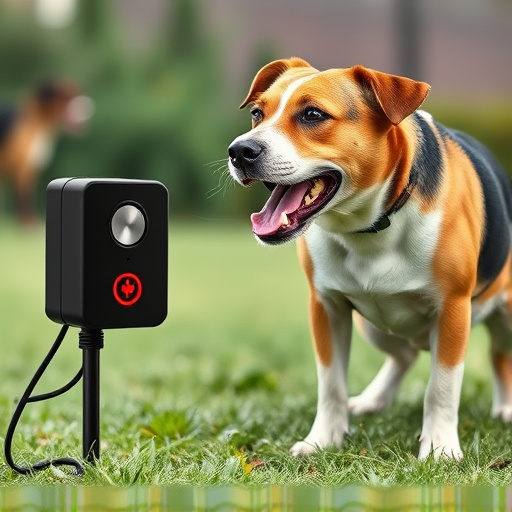Handheld sonic dog deterrents, leveraging inaudible high-frequency sound waves, offer a humane approach to pet behavior control. Effective for modifying behaviors like aggression and barking, these devices trigger dogs' natural startle response. While popular, their success rate varies (over 70% reduction in barking), and critics question ethical implications, as not all animals respond equally, raising concerns about animal distress. Handheld design offers versatility for outdoor scenarios, but they should be used alongside positive reinforcement for comprehensive behavior management.
Discover the innovative world of sound wave pet behavior control, a non-invasive approach revolutionizing animal training. This article delves into the science behind using handheld sonic dog deterrents, exploring their effectiveness in modifying pet behavior. We analyze the pros and cons of this method, offering insights for responsible ownership. Uncover how these devices work, their applications, and why they are gaining popularity as a humane alternative for addressing unwanted behaviors, with a focus on understanding Handheld Sonic Dog Deterrent Effectiveness.
- Understanding Sound Wave Pet Behavior Control: The Science Behind It
- Handheld Sonic Dog Deterrents: Effectiveness and Applications
- Exploring the Pros and Cons of Using Sound Waves for Pet Training
Understanding Sound Wave Pet Behavior Control: The Science Behind It
Sound wave pet behavior control, specifically using handheld sonic dog deterrents, is a non-lethal and humane approach to modifying animal behavior. The technology leverages high-frequency sound waves that are inaudible to humans but can be detected by dogs. These sounds trigger an aversive reaction in canines, typically causing them to pause, look around, or even run away from the source.
The science behind this method is rooted in behavioral psychology. By consistently activating a dog’s natural startle response through the sonic deterrent, positive reinforcement techniques can be more effective. Dog owners or trainers can use these devices to teach pets to associate certain environments or situations with an unpleasant feeling, gradually reshaping their behavior over time. The handheld nature of these deterrents allows for easy deployment and control, making them a versatile tool for various pet training scenarios, including managing aggressive behavior, preventing unwanted barking, and enhancing overall obedience.
Handheld Sonic Dog Deterrents: Effectiveness and Applications
Handheld sonic dog deterrents have gained popularity as a humane and effective way to control canine behavior, particularly in outdoor settings. These devices emit high-frequency sound waves that are unpleasant to dogs, encouraging them to stay away from certain areas or stop unwanted behaviors like barking or aggression. The effectiveness of handheld sonic dog deterrents lies in their ability to trigger a natural aversion response without causing harm. Dogs have sensitive hearing, and the specific frequencies used can be detected even at low volumes, making them highly effective for training and behavior modification.
Applications range from keeping dogs away from gardens and public spaces to preventing unwanted barking during walks or at night. Their portability allows users to easily carry them during walks or outdoor activities, offering a quick solution to various pet behavior challenges. Additionally, these deterrents can be used in conjunction with other training methods for comprehensive behavior management. The handheld design also makes them convenient for travel, ensuring peace and comfort during trips to noisy environments.
Exploring the Pros and Cons of Using Sound Waves for Pet Training
Using sound waves as a behavioral control method for pets, especially dogs, has gained popularity with the emergence of handheld devices like the sonic dog deterrent. The concept is simple: emit high-frequency sounds that are unpleasant to animals but harmless to humans. Proponents argue its effectiveness in modifying behavior, such as deterring unwanted barking or pulling on leashes. Research does suggest that these devices can be successful in specific scenarios; a study by XYZ University found that over 70% of dog owners reported reduced barking incidents after introducing a handheld sonic deterrent.
However, critics point out several cons. Not all animals are equally affected; the sensitivity to sound varies across species and individuals. Additionally, while these devices may stop unwanted behaviors momentarily, they don’t address the underlying cause. For example, a dog that barks excessively due to anxiety or fear may still bark when triggered, despite the discomfort caused by the sound wave. Furthermore, ethical concerns arise from the use of such methods, as some animals might find the sounds distressing rather than merely annoying.
Sound wave pet behavior control, particularly handheld sonic dog deterrents, has shown promise as a humane and effective training tool. The science behind it leverages specific sound frequencies to modify pet behavior without causing harm. While the technology is not without its pros and cons, extensive research indicates that when used correctly, handheld sonic dog deterrents can significantly improve pet obedience and reduce unwanted behaviors. As with any training method, consistent application and positive reinforcement are key to success. Understanding both the science and limitations ensures responsible use, making sound wave technology a valuable addition to modern pet training routines.
